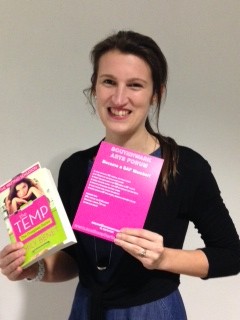Blogging can be a great way to establish yourself in your field, whatever your creative pursuit. It can help you to develop your brand and can gain you an audience for your product/s.
Last Thursday, I attended ‘Blogging for Creatives’, a workshop organised by Southwark Arts Forum and led by blogger and published author, Emily Benet. Blogs have been crucial to Benet’s success as a professional writer. Her first blog was published in book form in 2009 as Shop Girl Diaries. Benet is now the author of three books. The Temp (her third book) is due out this year.
Here are some gems I gleaned from the event about how to write a successful blog:
Choose a niche subject, something that you are an ‘expert’ on and that will be of interest to other people (besides your Mum).
This does not need to be something complicated or fancy. A cooking blog with a large readership, Joy the Baker, was started out of Joy’s obsession with cookies and cakes. Benet started her first blog because she was working full-time in her mother’s chandelier shop and therefore was an ‘expert’ on what it was like to talk to people who come into an unusual shop. As a writer, Benet used her niche subject to both entertain a readership and showcase her writing skills.
Be passionate about your subject.
Take some time before embarking on the project to think about whether you really are interested enough in your subject to maintain your blog. Building a readership takes time and commitment, so make sure you are in it for the long haul!
Take blogging seriously.
Blog regularly (at least once a week) and make sure that the quality of your blog posts is consistent. Do not write blog posts apologising for not having blogged for a while or for not having anything to blog about. You should blog well or not at all. While writing her first blog, Benet approached each blog post as though they were going to be published – and, while the internet is a form of publishing in itself, her posts were eventually collected in book form, so her hard work paid off.
Engage with your readers.
One of the main benefits of having a blog is that you can interact with your audience. Make sure that you have an About page stating who you are, what your blog is about and how you can be contacted. Enable your Comments box and respond to your readers’ comments. Add social media widgets/gadgets to your blog posts (even if you are not a part of them), so that your readers can share your posts. Use social media channels yourself to continue to build your brand, engage with readers and other people in your field. Benet advises joining two social media channels and using them regularly and consistently. Facebook and Twitter are two of the most popular social media channels (and remember to set up a separate Facebook page for professional use), but if your work is more visual, Instagram, Pinterest and Tumblr can be used to great effect.
Engage with your community.
Be part of an online community of creative people in your field. Interact with other bloggers by commenting on their blog posts and adding their blog to your blog roll – they may well return the favour. Similarly, follow bloggers and successful people in your field on Twitter and engage with them through tweets. Their readers/followers may spot you on their blog roll or Twitter feed and be interested enough to check out your blog and/or follow you on Twitter.
A word of warning about social media: Do not exclusively use them to sell your product/s. People will soon get bored of those ‘Check out my blog/book/painting/exhibition’ messages. Intersperse these messages with more interesting information, such as comments about the work of other people in your field.
And finally, here are five top tips for writing a good blog post:
1. A good title – to capture your readers’ interest.
2. Clarity – Make sure that your blog post is easy to read both in terms of content (well-structured, well-edited) and lay-out (no complicated fonts and always remember to leave lots of space around your text).
3. Consistency – Keep the quality of your blog posts consistent. And blog consistently!
4. Concision – It’s a good idea to keep your blog post between 300 – 500 words, even less if you are including visual material.
5. Visually appealing – It’s always great if you can include good quality images in your blog posts. If they are not your own images, always remember to credit the source.
So what are you waiting for? Get blogging!
[This blog first appeared on The Careers Service website]
